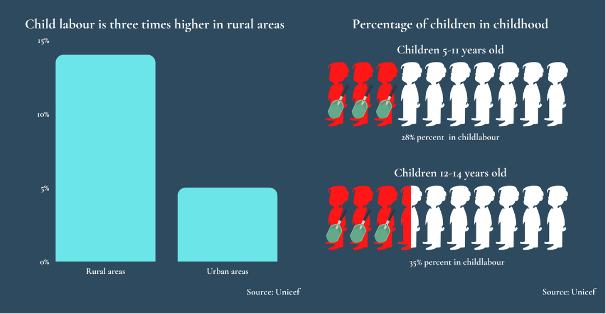We Must Reduce Child Labour
Child labour: definition and numbers
For the first time in twenty years, the number of children as victims of child labour raises. The ILO estimates that 160 million children are working in unethical conditions, and many more are at risk, especially due to the impact of COVID-19.
What is considered child labour? Let’s have a closer look at the definition.
When defining child labour, a distinction must be made between work committed by children that does not affect their personal development, health or participation in school, and work that does. Examples of the first type of work are helping parents out at home, helping out in a family business or earning pocket money. These types of work are not considered harmful.
Child labour comprises the second type of work mentioned. The term “child labour” is often defined as “work that deprives children of their childhood, their potential and their dignity, and that is harmful to physical and mental development”. The definition refers to work that is mentally, physically, socially or morally dangerous and harmful to children, as well as work that interferes with their schooling. Whether particular types of work and activities may be classified as child labour, depends on the child’s age, the type and hours of the work performed, the conditions under which the labour is performed and the objectives pursued by individual countries.

The report of Unicef provides further insight into the numbers of children in child labour. Unicef, together with the ILO, call for action to reduce these numbers. Member states, as well as businesses, trade unions, civil society, and regional and international organizations, are encouraged to make concrete action plans.
Want to make an individual difference? Through our database, you can check if a company stands up for child labour in its code of conduct. Furthermore, you can learn more about child labour at https://endchildlabour2021.org/. You could also come to action by buying from brands which are certified as completely child labour free. For example, Fair Wear offers a list of 148 brands which are reviewed on their implementation of the code of conduct.
|
Remarkable ⚠️ In an article from the 21st of october this year (2022), Reuters published that Korean auto giant Hyundai is investigating child labour violations in its U.S. supply chain. This is remarkable, since “common sense” tells us it’s usually the other way around, right? The hitch in the supply chain is taking place in one of the wealthiest countries in the world, while the Korean automotive giant, coming from a country that is often the subject of labour right violations, is investigating them. We wanted to take this opportunity to show that violation of fundamental labour rights can take place anywhere, even in the wealthiest countries in the world. We must learn from this, that we should always stay careful, wherever we are. |

